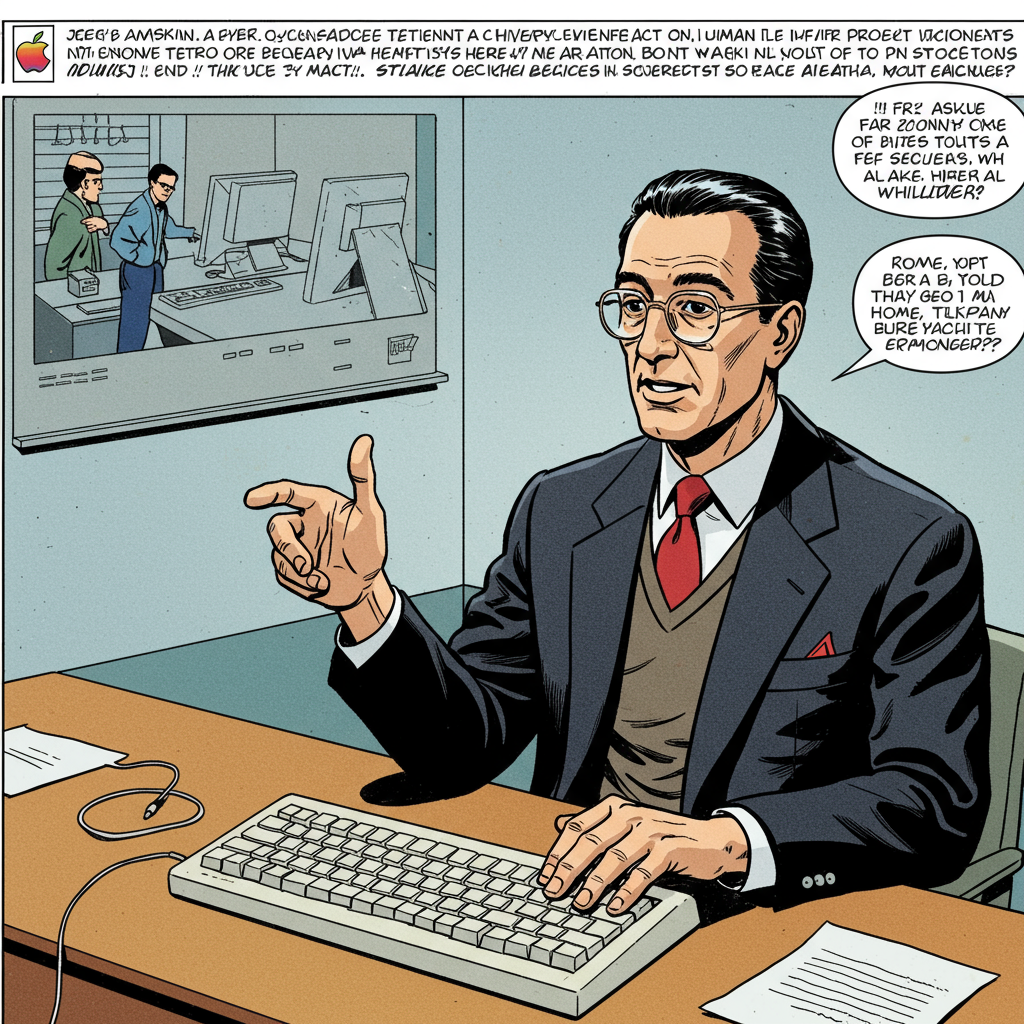Imagine a computer designed purely for human efficiency and intuition, where every interaction is consistent, valuable, and deeply respects our natural cognitive processes. Jef Raskin, the visionary behind the initial Macintosh project, dedicated his life to this “humane computer” quest. His pioneering ideas, focused on modeless, keyboard-driven interfaces, offered a stark alternative to the graphical, mouse-centric paradigms that ultimately dominated. While Raskin’s direct designs never achieved mainstream adoption, their underlying philosophy remains profoundly relevant. This article explores how you can personally experience his unique interface concepts, bringing a piece of computing history alive through accessible emulation.
Experiencing Jef Raskin’s Enduring Vision
Jef Raskin believed interfaces should be more than just usable. They needed to be “humane,” deeply aligned with how people think and form habits. He envisioned machines that were efficient, consistent, and useful. Above all, they had to be respectful and adaptable to human frailties. Raskin’s philosophy challenged the prevailing notions of desktop computing. He championed a unified workspace over discrete applications and files. He argued that separating functions into different programs was “excessive and burdensome.” His modeless approach aimed to eliminate errors and confusion. He felt interfaces should leverage human habit development. This ensured consistent commands for effortless mastery.
Raskin began his journey with the Macintosh project in 1979. He conceived it as a low-cost, self-contained, and non-expandable machine. He famously critiqued expansion slots as creating a “software nightmare.” His early Mac prototype had an 8-bit Motorola 6809 CPU and a keyboard-focused interface. It deliberately excluded a mouse. Raskin saw GUIs as better for graphics than text. He preferred trackballs or tablets. His vision for the Macintosh diverged sharply when Steve Jobs took over. Jobs pushed for a more powerful CPU and a mouse-driven graphical interface. This led to Raskin’s departure from Apple in 1982. The 1984 Macintosh 128K thus became a very different machine.
After leaving Apple, Raskin founded Information Appliance, Inc. (IAI). He sought to develop his ideas independently. This led to the “Swyft” computer, an all-in-one machine. It featured a built-in CRT, a floppy drive, and was always-on. Its operating system, written in a tokenized Forth dialect, focused on a radical “document” metaphor. This unified workspace allowed users to subdivide and edit a single, massive document. “LEAP keys” enabled quick navigation. They searched for text strings or document markers. This system avoided traditional file systems entirely. Everything saved and restored en masse.
Unearthing the Canon Cat Interface
Perhaps the most iconic representation of Raskin’s mature design principles is the Canon Cat. Canon sold it as an “overgrown word processor” in 1987. Yet, it was a full Motorola 68000-based computer. Users could program it through a hidden backdoor in its Forth dialect. The Cat operated on a single workspace. This workspace saved entirely to floppy disk. It could be subdivided into multiple “documents.” Users jumped between them quickly with key combinations. It even included basic spreadsheet and list functions.
The Canon Cat’s most famous feature was its exclusive reliance on the keyboard. There was no mouse or pointing device. This embodies Raskin’s modeless, keyboard-centric philosophy. Fortunately, you can experience the Canon Cat today. The well-known multi-system emulator, MAME, supports it. ROMs are readily available from the Internet Archive.
Emulating the Canon Cat: Setup and Navigation
To emulate the Canon Cat, download MAME and the necessary ROMs. Be aware that the MAME driver for the Cat is incomplete. It currently lacks floppy drive and serial port support. However, it offers a solid taste of the system’s operation. A notable MAME bug causes the emulated Cat to freeze when it attempts to beep. You must disable the beeper in the setup screen.
Here’s a quick guide:
Map the Cat’s USE FRONT key to your Control key.
Map the two pink LEAP keys to Alt or Option.
Hold USE FRONT, then press the left brace key (mapped to SETUP). Release SETUP, but keep USE FRONT down.
Tap SETUP again to reach the second screen.
With USE FRONT still down, tap the space bar. Cycle through options until you find “Problem signal.”
Tap one of the LEAP keys to set it to “Flash” (disabling the beep).
For better MAME compatibility, also set the keyboard type to ASCII.
Interacting with the Cat is unique. There are no cursor keys or a mouse. All movement happens through “leaping.” Hold down a LEAP key and type text to search for it. Single taps of either LEAP key “creep” you character by character. Special control sequences use the USE FRONT key with blue-marked function keys. For instance, USE FRONT-HELP (the N key) explains errors or reveals key functions.
The Canon Cat also includes a hidden Forth interpreter. Type “Enable Forth Language,” highlight it, then press USE FRONT-ANSWER (Control-Backspace in MAME). You’ll get a Forth “ok” prompt. This opens up low-level programming. Remember, Forth can be complex! Type “re” or reset the Cat to return to the editor. Sadly, the current MAME driver prevents saving documents to disk. Full documentation is available on the Internet Archive.
Exploring the SwyftCard on Apple IIe
Before the Canon Cat, Raskin’s backers pushed to release some technology aspects to raise capital. This initiative yielded the SwyftCard for the Apple IIe. Like the Cat, it used an editor on a single, subdivided workspace. This formed its core interface. Unlike the Cat, it was openly programmable, supporting Applesoft BASIC. It also featured LEAP and USE FRONT keys. Users even received stickers to label their Apple IIe keys. Its interface was exclusively keyboard-driven.
The SwyftCard’s simple design, combining a card and floppy disk, makes it relatively easy to reproduce. Some enthusiasts have even created clone cards. Today, the simplest way to experience it is through Eric Rangell’s software implementation. He developed this for KansasFest 2021. This software loads the original EPROM contents into high auxiliary RAM. It effectively functions as a modern “SwyftDisk,” a software-only version IAI later sold.
Setting Up SwyftCard Emulation
You can download Rangell’s software with ready-to-use disk images and manuals from the Internet Archive. It generally works with most Apple IIe emulators. Mariani and Virtual ][ are good choices. Ensure your emulator is configured for an enhanced IIe. It needs an 80-column card and at least one floppy drive in slot 6. It also works on a IIc, but not IIgs or II+. Run the system at Apple’s standard ~1MHz clock speed. The software is timing-sensitive.
To boot:
Start the emulated IIe with “SwyftCardResurrected.do.”
At the menu, select option 1. The SwyftCard ROM image loads.
When prompted, unmount the first disk. Change to “SwyftWare–SwyftCard_Tutorial.woz.” Press RETURN.
The SwyftCard tutorial will guide you. It explains the LEAP keys (Open and Closed Apple keys). In Mariani, Left and Right Option map to LEAP BACK and LEAP FORWARD. In Virtual ][, F5 passes the Command key. Then use Command for LEAP BACK and Option for LEAP FORWARD. For AppleWin, use the Windows keys. All these emulators use Control for USE FRONT.
The SwyftCard uses an 80-column non-proportional text display. The top bar shows the page number. Equals signs signify hard page breaks (subdocuments). Dashes mark soft page breaks after 54 lines. Navigation is via leaping. Hold a LEAP key and type a number or three equals signs to jump. You can also leap to arbitrary text. LEAP AGAIN (TAB) moves to the next occurrence. LEAP and ESC jump to hard page breaks. LEAP and RETURN jump to hard line breaks. Raskin emphasized releasing all keys fully after an operation. This serves as a mental reminder that you are no longer leaping.
Advanced SwyftCard Features
The SwyftCard features a “two-phased” cursor. By default, it’s “narrow” (solid/partially filled block). As you type, it becomes “wide.” The last character entered appears in inverse. This is what DELETE removes. The blinking portion after it is the insertion point. When you creep or leap, the cursor merges back to “narrow.” In narrow mode, DELETE truly deletes right, unlike a backspace.
Pressing both LEAP keys together selects a range. If you were typing, your recent text becomes selected. Delete it, then reinsert it elsewhere with USE FRONT-INSERT (Control-A). This allows for cut-and-paste. The SwyftCard allowed for on-the-fly evaluation of Applesoft BASIC. Highlight an expression, then press USE FRONT-CALC (Control-G). The editor computes the result. You can also write and execute full BASIC programs within the workspace.
Saving your work is straightforward. Insert a blank disk and press USE FRONT-DISK (Control-L). The editor saves the workspace with a unique ID. It prevents accidental overwriting of previously saved work. Highlighted text can transfer between disks. This allows cutting and pasting between workspaces. The SwyftCard also supported serial communication. USE FRONT-SEND (Control-D) sends highlighted text. Received data automatically integrates into the workspace at 300 baud.
Raskin’s Final Journey: The Humane Environment & Archy
Jef Raskin continued refining his software ideas until his death in 2005. In 2002, with his son Aza, he developed “The Humane Environment” (THE). This was a direct software implementation of his interface concepts. It centered on a core single-workspace editor, initially for Classic Mac OS. These early builds are self-contained. They run under Classic on Power Macs or natively in Mac OS 9. They include binaries, source code, and CodeWarrior projects. You can run them on later systems with SheepShaver or QEMU.
Downloading THE often requires an old-school MacCVS client. This correctly handles BinHexed files with resource forks. Once downloaded, find “HumaneEnvironment” in the ‘bin’ folder. Create a “Saved States” folder alongside it to avoid errors.
The Humane Environment (THE) Interface
Upon launching THE, create a new document with Command-N. In this early version, files were still accessed through the standard Macintosh file package. The two-tone cursor, familiar from the Cat and SwyftCard, is present. While fonts, bold, italic, and underlining worked, colors and font sizes used traditional Mac pulldown menus.
Leaping is central to THE. It’s integrated into a “Humane Quasimode.” Activate this by pressing SHIFT-SPACE. Keep SHIFT down. Press < or > to leap backward or forward. Then type your search text. The prompt appears as translucent text over the work area. Tasks like selection also occur in this Quasimode using the “S” command.
A key feature is the “DELETION DOCUMENT.” All deleted text automatically goes here. This provides a safety net. The undo operation was unreliable in early builds. You can rescue text from this document. It saves with the file. A full list of Quasimode commands is available by typing “COMMANDS.” These commands are based on Python files. You can modify and recompile them on the fly. CALC and RUN commands evaluate Python expressions and code directly within your document.
Archy: Raskin’s Unfinished Masterpiece
Subsequent builds of THE migrated to Windows. It was renamed “Archy.” This name honored Don Marquis’ literary insect and the Raskin Center for Humane Interfaces (RCHI). Archy remains unfinished. The final build (124, December 2005) runs on modern Windows PCs. It includes its own embedded Python interpreter.
Archy’s initial window cannot be resized. Its default font is no longer monospace. Size and color are fully controllable from within the editor. The document separator, a backtick, translates into a control character. Archy streamlined command input. Hold CAPS LOCK and type the command. Visual command completion is available. Archy’s tutorials are even narrated with voiceovers and animated keyboard demonstrations.
Leaping in Archy reverts to dedicated Left and Right Alt keys. Selection uses both leap keys. A significant advancement is pre-highlighting. Any text that will be selected is shown in light yellow. This makes selection much clearer. Archy aimed for a comprehensive environment, not just an editor. It included internet commands like EMAIL and GOOGLE. Commands in Archy are embedded Python snippets within the workspace. This offers a rich API for customization. The entire workspace, including all commands and settings, saves as a versioned text file upon exit. This provides an implicit history.
Raskin’s Legacy: A Cul-de-Sac or an Unfinished Path?
Jef Raskin’s quest for the humane computer led him down a path distinct from mainstream computing. His direct implementations, like the Canon Cat, faced commercial challenges. His unique innovations, such as pervasive Zooming User Interfaces (ZUIs) or application-less environments, haven’t permeated mainstream interfaces. Yet, his core philosophy remains influential.
Modern computing environments rarely implement his designs directly. However, they often incorporate principles he either espoused or pioneered. Raskin’s work highlights the backsliding of modern opaque operating systems. These systems often limit customization. Experiencing these emulations offers valuable insight into an alternative computing trajectory. It prompts us to consider what it would take to make today’s increasingly locked-down devices more humane. Raskin’s spirit persists in critical considerations of WIMP (windows, icons, menus, pointers) paradigm deficiencies. His insights address the needs of diverse users. While his editor-centric, application-less interface might seem like a “cul-de-sac,” its lessons are still pertinent for crafting more intuitive and user-respectful digital experiences.
Frequently Asked Questions
What defines Jef Raskin’s core philosophy for a “humane interface”?
Jef Raskin’s humane interface philosophy emphasizes efficiency, consistency, and respect for human cognitive abilities. He advocated for modeless interactions, arguing that different behaviors for the same command depending on context (modes) cause errors and confusion. His designs focused on a unified workspace, eliminating distinct “applications” and “files.” This allowed users to maintain a single mental model for all tasks. Raskin also championed keyboard-driven navigation, like “leaping,” to reduce cognitive load and leverage human habit formation for rapid productivity.
How can I emulate the Canon Cat or SwyftCard on my personal computer?
To emulate the Canon Cat, you’ll need the MAME emulator and the Canon Cat ROMs, available from the Internet Archive. Be prepared to implement a workaround for the Cat’s beeper bug within MAME. For the SwyftCard, Eric Rangell’s software implementation is ideal. Download it with disk images from the Internet Archive. You’ll need an Apple IIe emulator (like Mariani or Virtual ]) configured for an enhanced IIe, an 80-column card, and a floppy drive. Both experiences offer unique insights into Raskin’s keyboard-centric designs.
Why should modern users explore Jef Raskin’s “outdated” computer interfaces?
Exploring Raskin’s interfaces offers a unique perspective on user experience design and human-computer interaction. It demonstrates an alternative path computing could have taken, one prioritizing cognitive ease and user control over visual complexity. Modern systems often suffer from modal dialogues, application silos, and limited customization. Raskin’s designs provide a counter-narrative, highlighting the value of consistency, efficiency, and respecting human learning patterns. Experiencing these systems can inspire current designers and users to question conventional UI paradigms and advocate for more genuinely humane digital tools.
The journey through Jef Raskin’s humane interfaces offers a compelling glimpse into a different computing reality. From the keyboard-exclusive Canon Cat to the programmable SwyftCard and the evolving Archy environment, Raskin consistently prioritized the user’s cognitive experience. His ideas, though often outside the mainstream, continue to challenge us. They push us to consider how our digital tools can better serve humanity. Emulating these systems is more than a historical exercise. It is an opportunity to re-evaluate what makes an interface truly “humane.” And it invites us to champion design that is thoughtful, intuitive, and ultimately, more respectful of us.
References
- [arstechnica.com
- arstechnica.com




